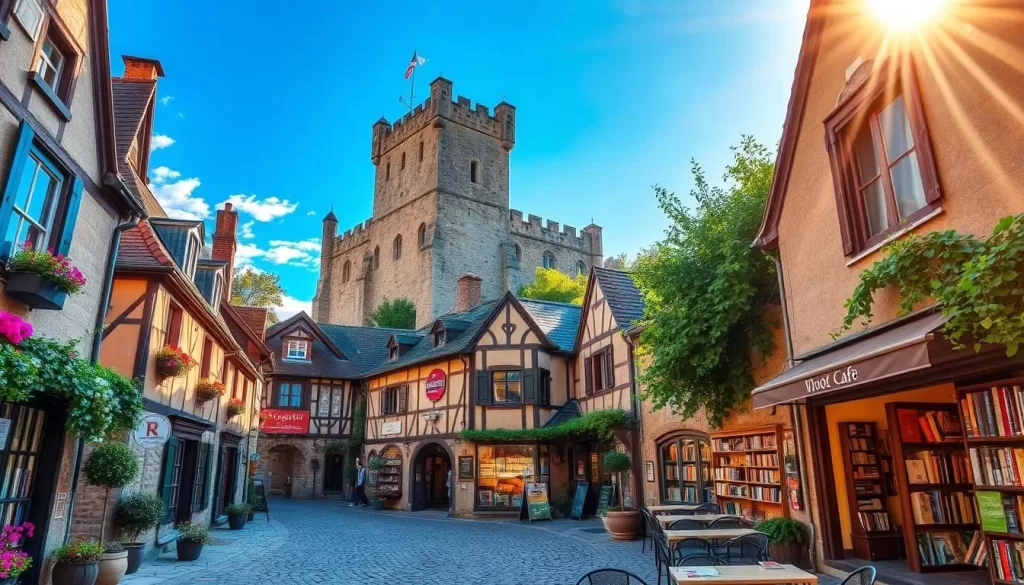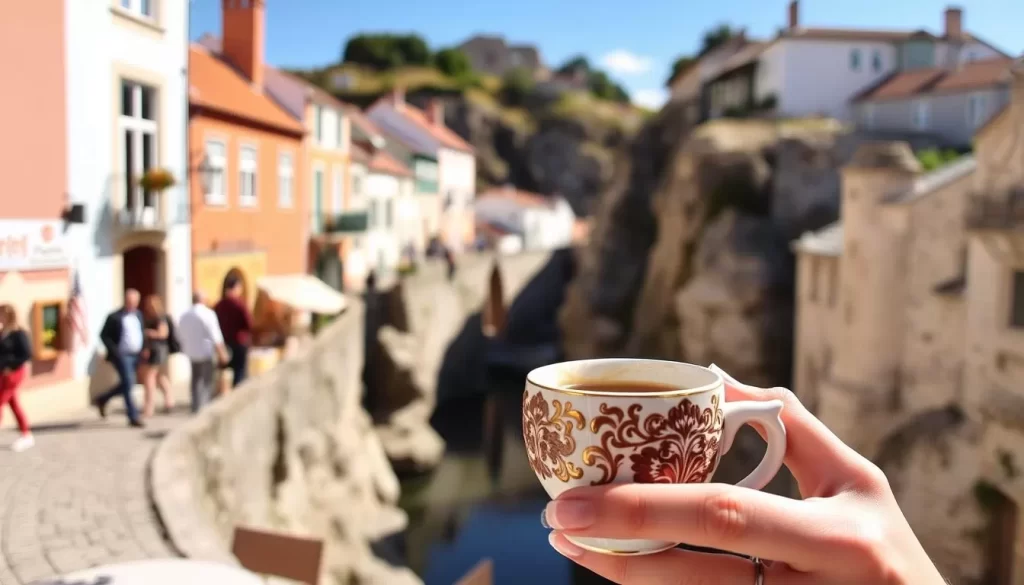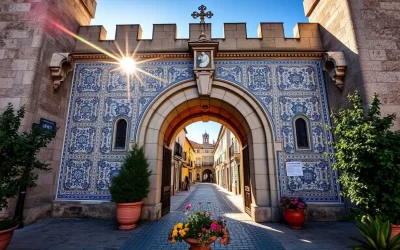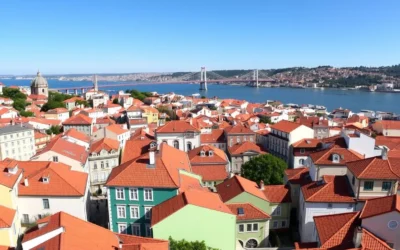✓ Accommodations✓ Flights✓ Rental Cars✓ Tours & Activities
Discover the charm of Óbidos, a medieval walled town nestled in the hills of Portugal. This picturesque destination is a must-visit, boasting well-preserved architecture, whitewashed buildings, and narrow cobblestone streets.
Located about 85 kilometers north of Lisbon, Óbidos is often visited as a day trip, but it deserves more time to appreciate its unique character. As you explore the walls and historic churches, you’ll uncover the rich cultural heritage of this enchanting place.
This guide will help you make the most of your visit, whether you’re stopping for a few hours or staying overnight. With its designation as a UNESCO Creative City for Literature, Óbidos offers a wealth of experiences, from exploring historic sites to savoring local delicacies.
Discovering the Medieval Charm of Óbidos
The historic town of Óbidos is a treasure trove of medieval architecture, rich history, and captivating charm. As you wander through its narrow streets and explore its historic sites, you’ll uncover the layers of history that have shaped this enchanting town.
A Brief History of Óbidos
Óbidos has a rich and varied history that spans centuries. The Moors were the first to settle here, but in the 12th century, Alfonso Henriques, the first king of Portugal, took over the area. In 1228, King Dinis I gifted the town of Óbidos to his wife, Elizabeth of Aragon, starting a tradition where Óbidos was given as a dowry to many Portuguese queens until the 19th century. This royal connection has contributed to the town‘s unique character and preservation.
| Event | Year | Description |
|---|---|---|
| Moorish Settlement | Before 12th century | The Moors first settled in Óbidos. |
| Conquest by Alfonso Henriques | 12th century | Alfonso Henriques took over Óbidos from the Moors. |
| Gift to Queen Elizabeth | 1228 | King Dinis I gifted Óbidos to his wife, Elizabeth of Aragon. |
Why Óbidos Should Be on Your Portugal Itinerary
Óbidos is a place that transports you back in time, with its well-preserved medieval architecture and historic significance. The castle and the town’s defensive walls are testaments to its strategic importance throughout history. Unlike some of Portugal’s more famous destinations, Óbidos offers a more authentic and less crowded experience. Its compact size makes it perfect for exploring on foot, allowing you to soak in the medieval ambiance at a leisurely pace.
![]()
Walking the Fortified Walls of Óbidos
Óbidos’ 1.5 km loop of medieval walls offers a truly unforgettable experience for visitors. As you walk along these ancient fortifications, you’ll be treated to breathtaking views of the town and its surroundings.

Best Time to Experience the Walls
The time of day can greatly impact your experience. Visiting during the golden hour, either early in the morning or late in the afternoon, is highly recommended. The soft light is perfect for photography, and the temperatures are more comfortable for walking.
What to Expect During Your Walk
As you make your way along the walls, expect narrow pathways (approximately 1 meter wide) and uneven surfaces. There are no guardrails in many sections, so be mindful of your step. The walk is approximately 30-60 minutes to complete the full circuit, depending on your pace and how often you stop to take in the views or capture photos at various spots along the way.
Tips for Walking the Walls Safely
To ensure a safe and enjoyable experience, wear comfortable shoes with good grip, and avoid walking the wall during rainy or windy conditions. Be cautious of two-way traffic on narrow sections, and consider using the staircase near Porta da Vila (the main gate) as your access point to the walls, as it’s one of the most popular stairs leading up to the walkway.
Exploring Porta da Vila – The Main Entrance
Your journey into the heart of Óbidos begins at Porta da Vila, an impressive gateway that has stood the test of time. This historic gate is not just a passage into the village; it’s an introduction to the rich history and architectural beauty of Óbidos.
The Historical Significance of the Gate
The double-arched gate was designed with a zigzag entrance, a clever medieval strategy to prevent direct cavalry charges. This architectural feature highlights the gate’s historical significance as part of Óbidos’ defensive system. It also served as a point where travelers would stop to pray at the small chapel dedicated to Nossa Senhora da Piedade.
The Beautiful Blue Tiles (Azulejos)
As you pass through Porta da Vila, you’ll be greeted by the stunning 18th-century blue and white tiles that adorn the interior. These azulejos, added between 1740 and 1750, beautifully depict scenes from the Passion of Christ. The intricate tilework is a testament to the craftsmanship of the period and adds to the gate’s beauty, making it a great spot for photography as you enter the village through this historic entrance.

Strolling Through Rua Direita – The Main Street
As you step into the heart of Óbidos, you’ll find yourself on Rua Direita, the charming main street that connects Porta da Vila to the castle. This historic street is lined with whitewashed buildings adorned with colorful flowers, creating a picturesque scene that’s perfect for a leisurely stroll.
Shopping Opportunities
Rua Direita offers a variety of shopping experiences, from artisanal craft shops to bookstores that reflect Óbidos’ status as a UNESCO Literary City. You can also find ceramic stores selling traditional Portuguese pottery and shops offering local products like ginja liqueur. As you explore, you’ll discover unique souvenirs and gifts that capture the essence of Óbidos.
| Shop Type | Products |
|---|---|
| Artisanal Craft Shops | Handmade crafts, local jewelry |
| Bookstores | Literary works, local authors |
| Ceramic Stores | Traditional Portuguese pottery |
Cafés and Restaurants Along the Way
The street is dotted with charming cafés and restaurants where you can rest and enjoy Portuguese pastries, coffee, or a traditional meal. These spots are perfect for people-watching and soaking up the atmosphere. Be sure to try some local delicacies, such as ginja in a chocolate cup, a unique treat that Óbidos is known for.
Visiting the Castle of Óbidos

As you explore Óbidos, visiting the Castle is an absolute must, given its historical significance and architectural grandeur. The Castle of Óbidos is a treasure trove of history, having been a Roman fortification, later fortified under Arab rule, and then taken over by Christian rule in 1148.
The History of the Castle
The Castle dates back to Roman times and has undergone significant transformations, including being severely damaged in the 1755 earthquake and later restored in the 20th century. It is now recognized as one of the Seven Wonders of Portugal. Its rich history and architectural evolution make it a fascinating site to explore.
The Castle Hotel Experience
Today, the Castle operates as a 4-star hotel, known as Pousada Castelo de Óbidos, offering guests a unique chance to stay within the historic walls. Even if you’re not a guest, you can visit the castle courtyard and enjoy the views from the terrace. The castle’s restaurant serves traditional Portuguese cuisine in a truly atmospheric setting, making it a must-visit for any traveler.
The Castle of Óbidos is particularly magical in the evening when illuminated, making it worth visiting both during the day and after dark. Its central role in the town’s history and its status as the most iconic landmark make it an unforgettable experience.
Óbidos, Portugal: Best Things to Do – Top Picks for Literary Lovers
Óbidos’ transformation into a UNESCO Creative City of Literature has made it a paradise for literary enthusiasts. The town’s historic buildings have been repurposed into charming bookshops, creating a unique literary landscape.
Exploring the Bookshops of the Literary City
The Vila Literária project has been instrumental in Óbidos’ literary transformation, turning abandoned buildings into vibrant bookstores. Notable among these is the Livraria de São Tiago, housed in a 12th-century church, offering a blend of history and literature. Visitors can explore various bookshops selling new and second-hand books in multiple languages, though Portuguese titles are predominant. Literary-themed souvenirs such as bookmarks and notebooks are also available, celebrating Óbidos’ literary culture.
| Bookshop Name | Location | Specialty |
|---|---|---|
| Livraria de São Tiago | North end of town, near the castle | Rare and antique books |
| Livraria do Castelo | Inside the castle walls | Portuguese literature |
The Literary Man Hotel
The Literary Man Hotel is a haven for bibliophiles, boasting over 65,000 books throughout its premises. Guests can browse the extensive collection while enjoying a meal or drink, making it a unique experience that combines hospitality with a love of literature. The hotel’s literary focus aligns perfectly with Óbidos’ status as a literary city, making it a must-visit for anyone attending the annual FOLIO (Óbidos International Literary Festival).

Tasting Ginja in a Chocolate Cup

When in Óbidos, you can’t miss the opportunity to taste Ginja, a local specialty. Ginja, also known as ginjinha, is a famous Portuguese sour cherry liqueur that has become synonymous with a visit to Óbidos, especially when served in an edible chocolate cup.
The History of Ginja in Óbidos
Ginja is produced throughout Portugal, but the Óbidos version is particularly renowned. The production process involves harvesting sour cherries in June and then steeping them in a mixture of water, alcohol, and sugar for several months. This creates a distinctive cherry liquor that is both tart and sweet.
Best Places to Try This Local Delicacy
Some of the best places to try Ginja in Óbidos include Bar Ibn Errik Rex, which was the first establishment to serve Ginja in the 1950s, and Ginjinha d’Óbidos. You can also find this local delicacy at various shops along Rua Direita. Ginja tasting has become a ritual for visitors, with samples available for around €1-2 per chocolate cup serving.
You can also purchase a bottle of Ginja as a souvenir. Brands like Oppidum and Vila das Rainhas produce high-quality Ginja, making for a great regional specialty to take home.
Visiting the Historic Churches of Óbidos
The town of Óbidos boasts a rich spiritual history, evident in its beautiful churches. As you wander through the town, you’ll encounter several historic churches that are not only significant religious sites but also repositories of art, history, and culture.
Church of Saint Mary (Igreja de Santa Maria)
The Church of Saint Mary is the main religious building in Óbidos, known for its stunning interior adorned with beautiful blue and white azulejo tiles. This church has played host to several royal weddings, including the marriage of King Alfonso V to his cousin, D. Isabel, in 1441, when the couple were just ten and eight years old, respectively. The church is also home to the Renaissance tomb of D. João de Noronha and his wife, D. Isabel de Sousa, considered one of the best examples of Portuguese Renaissance tombs.
Church of Misericórdia
The Church of Misericórdia, or Church of Mercy, dates back to 1498 when it was founded by Queen Leonor as part of an almshouse. In the 17th century, it served as a place of worship for the sick and the poor. The interior walls of this church are covered with beautiful blue tiles, adding to its historical and architectural significance.
| Church Name | Notable Features | Historical Significance |
|---|---|---|
| Church of Saint Mary | Blue and white azulejo tiles, Renaissance tomb | Royal weddings, including King Alfonso V |
| Church of Misericórdia | Blue tiles | Founded by Queen Leonor in 1498, served the sick and poor |

Dining Experiences in Óbidos

Óbidos offers a delightful dining experience, blending traditional Portuguese cuisine with a historic ambiance. From casual cafés to upscale restaurants, there’s something for every palate.
Traditional Portuguese Cuisine
When dining in Óbidos, be sure to try traditional Portuguese dishes such as bacalhau (salt cod prepared in various ways), sardines on corn bread, and seafood rice. Local stews are also a staple, offering a hearty and flavorful experience. Many restaurants incorporate the town’s famous cherry liqueur (ginja) and chocolate into their dessert menus, providing a sweet conclusion to your meal.
Top Restaurant Recommendations
For an authentic dining experience, head to Tasca Torta on Rua Direita, known for its excellent seafood. The atmospheric Book & Cook Restaurant at The Literary Man Hotel is another highlight, offering a unique blend of literature and cuisine. For tapas and ginja, visit Bar Ibn Errik Rex. Just outside the castle walls, Ja!mon Ja!mon, Potinha, and A Nova Casa de Ramiro are worth visiting.
To avoid crowds, consider dining during off-peak hours. Lunch is typically served from 12:30-3:00 PM, and dinner from 7:30-10:00 PM. Reservations are recommended, especially during high season or weekends.
Festivals and Events in Óbidos
Óbidos transforms into a vibrant destination during its festivals and events throughout the year. The town’s historic center and castle provide an atmospheric backdrop for these celebrations, making them even more special.
The International Chocolate Festival
The International Chocolate Festival, held in March/April, is a paradise for chocolate lovers. You can enjoy tastings, workshops, chocolate sculptures, and cooking demonstrations. It’s a unique experience that combines Óbidos’ medieval charm with the delight of chocolate.
The Medieval Festival
In July, Óbidos hosts the Medieval Festival, where the town returns to its medieval roots. You can expect period costumes, authentic food, crafts, music, jousting tournaments, and theatrical performances. It’s an immersive experience that transports you back in time.
Other Notable Events
Other notable events include the FOLIO (Óbidos International Literary Festival) in October, celebrating the town’s UNESCO Creative City of Literature status, and the magical Christmas Village from December to early January. These events make Óbidos an exciting destination at different times of the year.
| Event | Time | Description |
|---|---|---|
| International Chocolate Festival | March/April | Chocolate tastings, workshops, and demonstrations |
| Medieval Festival | July | Medieval-themed event with costumes, food, and performances |
| FOLIO Literary Festival | October | Literary events, author talks, and book launches |
| Christmas Village | December/January | Festive decorations, ice rink, Santa’s house, and holiday activities |
Day Trips from Óbidos
With its central location, Óbidos serves as an ideal base for day trips to various significant sites in Portugal. You can explore numerous attractions within a short time, making the most of your visit.
Nazaré and Its Giant Waves
Nazaré, just 40 km away, is a must-visit destination famous for its record-breaking giant waves in winter, reaching up to 30 meters high. Experience the traditional fishing culture and enjoy the beautiful beaches.
The Monasteries of Alcobaça and Batalha
The Alcobaça Monastery, a UNESCO World Heritage Site, is renowned for its Gothic architecture and the tragic love story of Pedro and Inês. The Batalha Monastery, another UNESCO site, features stunning Manueline architecture and the Unfinished Chapels.
Fátima Pilgrimage Site
Fátima is one of the world’s most important Catholic pilgrimage sites, where the Virgin Mary reportedly appeared to three shepherd children in 1917. Millions of visitors flock here annually, making it a significant tour destination.
Image of Fátima Pilgrimage Site
You can take a bus or drive to these destinations, with guided tour options available from Óbidos. Combining nearby sites like Alcobaça and Batalha in a single day trip is a great way to explore efficiently.
Conclusion: Making the Most of Your Visit to Óbidos
Visiting Óbidos is like stepping into a fairy tale, with its charming streets and historic landmarks. This perfectly preserved medieval town offers a unique journey back in time, allowing you to explore its fortified walls, castle, churches, and picturesque streets.
To make the most of your trip to Óbidos, allocate a few hours to stroll through the town, walk the walls, and enjoy lunch or dinner at one of the local eateries. However, staying overnight can provide a more magical experience, as you can wander the streets in the evening and next morning without the crowds of day trippers.
The best time to visit Óbidos is during the shoulder seasons (spring and fall), when the weather is pleasant and crowds are smaller. You can reach Óbidos by car, bus, or train, or take an organized tour from Lisbon or other major cities. For accommodation, choose from luxury hotels like the Pousada in the castle, charming guesthouses within the walls, or more affordable options just outside.
In conclusion, Óbidos is a must-visit destination that perfectly balances historical significance with modern charm. Whether you visit during the day or stay overnight to enjoy the town under the stars, Óbidos is sure to leave a lasting impression on your travel memories.
The above is subject to change.
Check back often to TRAVEL.COM for the latest travel tips and deals.






